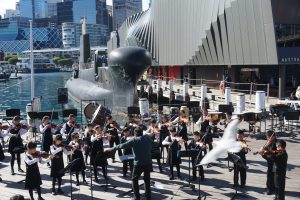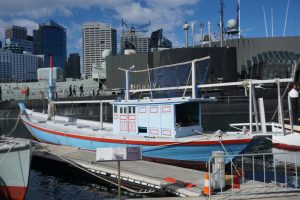The Australian National Maritime Museum is a cultural destination on the waterfront of Sydney Harbor. With over 500,000 visitors annually, it connects visitors with the maritime history of the nation with objects, stories, and public programs. However, what makes this museum stand out is the array of vessels spanning centuries of maritime technological advances that float adjacent to the main museum building. This includes a full-scale replica of Captain James Cook’s HMB Endeavour, which on its first voyage of discovery (1769-1771) sailed to Australia and New Zealand. After her construction, this replica circumnavigated Australia over a 13-month period in an act of public outreach for the institution. A standout theme however is seen throughout the museum, witnessed both in exhibitions inside the main building and in the interpretation provided for the vessels docked adjacent to it. This theme is immigration.

With a backdrop of Australian maritime heritage young musicians play on the waterfront of Sydney harbor.
Decommissioned vessels from the Royal Australian Navy, including the destroyer HMAS Vampire and the submarine HMAS Onslow, are docked outside and greet visitors as they exit the main museum building shedding light onto Australia’s Cold War past. When I exited the museum onto the waterfront I was greeted by a wonderful example of public space. The waterfront itself is open to the public, as evident with runners and walkers passing by in the hundreds in this space between the museum building and nearby historic vessels. A pass purchased inside the museum allows visitors to gain access to the exhibitions located onboard. A group of young musicians played for a gathered crowd in front of a collection of museums vessels.

Hull of the HMAS Vampire.
The museum retains a strong commitment to education and offers over 30 workshops and tours in a range of curriculum areas for primary and secondary students. One tour and vessel in particular stands out in commemorating the Cold War, but also brings factual and human context to the issue of migration to Australia.
A Boat Called Freedom
Docked next to a 295-foot submarine is Tu Do, a small craft of 50 feet with an engine of just 43 horsepower. Originally purposed as a Vietnamese fishing vessel and secretly outfitted in 1975 for an exodus leaving the recently invaded South Vietnam by the communist forces from the North, this small vessel functions today as an educational platform in commemorating brave individuals seeking freedom. The museum acquired the vessel in 1990, however, it was not until 1995, after tracking down the original owner, a Mr. Tan Thanh Lu, that the full provenance of the craft came into focus. When fully understood, the story of Tu Do, which translates from Vietnamese into A Boat Called Freedom, offered a unique mechanism for discussing the national story of immigration to Australia which is one of the most ethnically diverse nations in the world with one in four residents born overseas.

Tu Do
Lu built Tu Do as a traditional Vietnamese fishing vessel that he personally operated for six months in 1975 to avoid any suspicion from the communist authorities while he developed a clandestine escape plan. The secret plan called for Lu to fake engine troubles and be towed back to harbor, which allowed him to work on Tu Do and not be immediately suspected and targeted with surveillance for working on his vessel. This ploy granted him a brief window of opportunity to install a more powerful engine and make other modifications for open ocean travel.
On a dark night, with the Tu Do loaded down with 38 people including his pregnant wife, infants, other relatives, neighbors, and friends, Lu embarked on a journey to freedom. Lu avoided detection in escaping Vietnam and the pirates in the Gulf of Thailand preying on those fleeing the communist state, and after very brief stops to resupply in Malaysia and Indonesia, this 50-foot vessel traveled 6000 km and landed two months later near Darwin on the northern coast of Australia. Mr. Lu’s epic journey, of crossing an ocean with only a handheld compass and a map torn from a school textbook, brings to life the story behind a small fishing vessel afloat among a collection of ships. Mr. Lu, on visiting his fishing boat, said, “Making the decision to escape is like going to war. You do it because you think it’s necessary, but you never want to do it twice.”
In the immigration secondary education program students examine objects brought to Australia in the 1950s by migrants. Objects handled and discussed in the workshop shed light into specific migrations to the nation in the 1950s, including Japanese war brides who married Australian servicemen after World War II. Students gather around a large map placed on the floor and together trace the journeys of other groups traveling to Australia in the 20th Century in search of a better life. In discussing the fleeing of Vietnam in the mid 1970s, students consider the perils associated with traveling in crowded boats on the open ocean. With the workshop completed, students take two tours, the first of which is to the archives to see objects personally brought to Australia by children. Second, the school groups walk onto a floating dock and tour Tu Do. With background knowledge from the workshop and collections tour, students see first hand a Vietnamese refugee boat that for over 2 months braved the sea with a 43 horsepower motor and transported over 30 people to freedom.

View of the Sydney skyline from aboard.
The Australian National Maritime Museum for over 20 years has fulfilled the mission of linking the nation of Australia with its maritime roots. This museum serves as an international example in the multiple roles successful institutions can complete in commemorating maritime history. With the use of human stories interwoven with national and technological narratives, the curators of this museum demonstrate the potential of public history utilizing maritime history.







